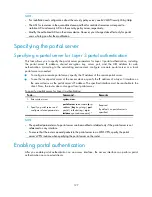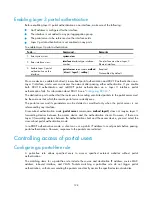
129
To configure a portal-free rule:
To do…
Command…
Remarks
1.
Enter system view.
system-view
—
2.
Configure a portal-free rule.
portal free-rule
rule-number
{
destination
{
any
|
ip
{
ip-address
mask
{
mask-length
|
netmask
} |
any
} } |
source
{
any
| [
interface
interface-type
interface-
number
|
ip
{
ip-address
mask
{
mask-length
|
mask
} |
any
} |
mac
mac-address
] * } } *
Required
When configuring portal free rules:
•
You cannot configure two or more portal-free rules with the same filtering criteria. Otherwise, the
system prompts that the rule already exists.
•
Regardless of whether portal authentication is enabled, only add or remove a portal-free rule rather
than modifying it.
Configuring an authentication source subnet
Only Layer 3 portal authentication supports this feature.
By configuring authentication source subnets, you specify that only HTTP packets from users on the
authentication source subnets can trigger portal authentication. If an unauthenticated user is not on any
authentication source subnet, the access device discards all the user's HTTP packets that do not match
any portal-free rule.
To configure an authentication source subnet:
To do…
Command…
Remarks
1.
Enter system view.
system-view
—
2.
Enter interface view.
interface
interface-type
interface-
number
—
3.
Configure an authentication
source subnet.
portal auth-network
network-
address
{
mask-length
|
mask
}
Optional.
By default, the authentication
source subnet is 0.0.0.0/0, which
means that users from any subnets
must pass portal authentication.
When configuring portal authentication source subnets:
•
Configuration of authentication source subnets applies to only cross-subnet authentication.
•
In direct authentication mode, the authentication source subnet is 0.0.0.0/0.
•
In re-DHCP authentication mode, the authentication source subnet of an interface is the subnet to
which the private IP address of the interface belongs.
•
Configure multiple authentication source subnets by executing
portal auth-network
repeatedly.






























